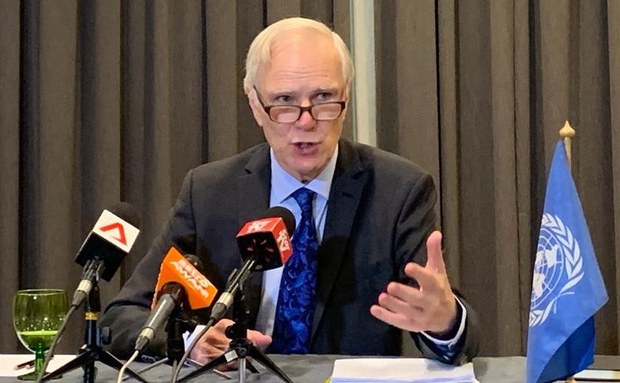Malaysia’s Almost Zero Poverty Level Inaccurate, UN Envoy Says
2019.08.23
Kuala Lumpur
 U.N. Special Rapporteur Philip Alston speaks to the media about his findings in Kuala Lumpur, Aug 23, 2019.
U.N. Special Rapporteur Philip Alston speaks to the media about his findings in Kuala Lumpur, Aug 23, 2019.
Malaysia’s poverty rate is much higher than the country’s official figure, a U.N. expert said Friday as he questioned the Southeast Asian country’s claim that it has almost eradicated poverty.
The government claims that the poverty rate is 0.4 percent but Philip Alston, the U.N. special rapporteur on extreme poverty and human rights, said it could be up to 20 percent, based on independent analyses.
“The official claim that poverty has been eradicated or exists merely in small pockets in rural areas, is incorrect and has crippled policymaking,” Alston told a news conference in Kuala Lumpur at the end of an 11-day visit to the country.
“The government’s official figures would make it the world champion in eliminating poverty ... but I think it's pretty obvious that that's not the case.”
Alston said a range of rigorous independent analyses had suggested “a more realistic poverty rate of 16 to 20 percent, and that about 9 percent of households survive on less than 2,000 ringgit (U.S. $479) per month.”
Prime Minister Mahathir Mohamad said the government would study the claim.
“We will study what they say to find out whether it is true or not,” the state-run news agency Bernama quoted him as telling reporters at a fundraising dinner.
Just after Alston’s news conference, Minister of Economic Affairs Mohamed Azmin Ali expressed “disappointment” at Alston’s statement and defended the official statistics, saying they were derived from internationally accepted standards, using figures from a handbook published by the United Nations.
“We stand by our absolute poverty rate, which is currently recorded at 0.4 percent of total households in 2016 or 24,700 households,”Azmin said in a statement. The country’s current official poverty rate, which fell from 49 percent in 1970, implies that poverty has been nearly wiped out.
Alston also described the national poverty line of 980 ringgit ($234) per household monthly as “tragically low” because it would mean that an urban family of four would have to survive on less than $2 per person each day.
The undercount has led to too many underfunded programs in place, affecting indigenous people who are experiencing the highest poverty rate, he said.
He also expressed concern over the child poverty rate in Malaysia, which he said was three times the national poverty rate, saying the government does not appear to have an adequate support system for addressing the issue.
He cited a 2018 UNICEF survey of low-income flats in Malaysia’s capital Kuala Lumpur and neighboring Selangor state which he said found 15 percent of children younger than 5 were underweight.
![190823-UN-620-INSIDE.jpg U.N. Special Rapporteur Philip Alston (right) speaks to low-income families in Kuala Lumpur during his 11-day visit, Aug. 23, 2019. [Bassam Khawaja/U.N.]](/english/news/malaysian/Malaysia-poverty-08232019174656.html/190823-UN-620-INSIDE.jpg/@@images/b23fd35a-c370-40a1-90b2-fc999640378c.jpeg)
In June, the local Khazanah Research Institute published a report indicating structural weaknesses with the official poverty measures used to arrive at the government statistics. Among others, it concluded that more Malaysians would be poorer if adjustments were made to reflect reality.
Alston recommended that a “meaningful” poverty line, consistent with international standards, be adopted urgently in Malaysia, saying the current level is “not consistent with the cost of living or household income.”







